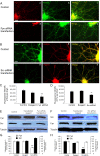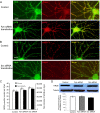Dopamine D1 receptor-mediated NMDA receptor insertion depends on Fyn but not Src kinase pathway in prefrontal cortical neurons
- PMID: 20569495
- PMCID: PMC2902469
- DOI: 10.1186/1756-6606-3-20
Dopamine D1 receptor-mediated NMDA receptor insertion depends on Fyn but not Src kinase pathway in prefrontal cortical neurons
Abstract
Background: Interactions between dopamine and glutamate in the prefrontal cortex are essential for cognitive functions such as working memory. Modulation of N-methyl-D-aspartic acid (NMDA) receptor functions by dopamine D1 receptor is believed to play a critical role in these functions. The aim of the work reported here is to explore the signaling pathway underlying D1 receptor-mediated trafficking of NMDA receptors in cultured rat prefrontal cortical neurons.
Results: Activation of D1 receptor by selective agonist SKF-81297 significantly increased the expression of NR2B subunits. This effect was completely blocked by small interfering RNA knockdown of Fyn, but not Src. Under control conditions, neither Fyn nor Src knockdown exhibited significant effect on basal NR2B expression. D1 stimulation significantly enhanced NR2B insertion into plasma membrane in cultured PFC neurons, a process obstructed by Fyn, but not Src, knockdown.
Conclusions: Dopamine D1 receptor-mediated increase of NMDA receptors is thus Fyn kinase dependent. Targeting this signaling pathway may be useful in treating drug addiction and schizophrenia.
Figures







Similar articles
-
Dopamine receptors regulate NMDA receptor surface expression in prefrontal cortex neurons.J Neurochem. 2008 Sep;106(6):2489-501. doi: 10.1111/j.1471-4159.2008.05597.x. Epub 2008 Jul 30. J Neurochem. 2008. PMID: 18673451 Free PMC article.
-
Synergistic interactions of dopamine D1 and glutamate NMDA receptors in rat hippocampus and prefrontal cortex: involvement of ERK1/2 signaling.Neuroscience. 2009 Nov 10;163(4):1135-45. doi: 10.1016/j.neuroscience.2009.07.056. Epub 2009 Jul 30. Neuroscience. 2009. PMID: 19647050
-
Dopamine D1-dependent trafficking of striatal N-methyl-D-aspartate glutamate receptors requires Fyn protein tyrosine kinase but not DARPP-32.Mol Pharmacol. 2004 Jan;65(1):121-9. doi: 10.1124/mol.65.1.121. Mol Pharmacol. 2004. PMID: 14722243
-
Regulation of NMDA receptors by the tyrosine kinase Fyn.FEBS J. 2012 Jan;279(1):12-9. doi: 10.1111/j.1742-4658.2011.08391.x. Epub 2011 Dec 5. FEBS J. 2012. PMID: 21985328 Review.
-
Targeting prefrontal cortical dopamine D1 and N-methyl-D-aspartate receptor interactions in schizophrenia treatment.Neuroscientist. 2005 Oct;11(5):452-70. doi: 10.1177/1073858405279692. Neuroscientist. 2005. PMID: 16151046 Review.
Cited by
-
Group II metabotropic glutamate receptor agonist LY379268 regulates AMPA receptor trafficking in prefrontal cortical neurons.PLoS One. 2013 Apr 12;8(4):e61787. doi: 10.1371/journal.pone.0061787. Print 2013. PLoS One. 2013. PMID: 23593498 Free PMC article.
-
The Signaling and Pharmacology of the Dopamine D1 Receptor.Front Cell Neurosci. 2022 Jan 17;15:806618. doi: 10.3389/fncel.2021.806618. eCollection 2021. Front Cell Neurosci. 2022. PMID: 35110997 Free PMC article.
-
Directional gating of synaptic plasticity by GPCRs and their distinct downstream signalling pathways.EMBO J. 2012 Feb 15;31(4):783-5. doi: 10.1038/emboj.2012.3. Epub 2012 Feb 15. EMBO J. 2012. PMID: 22334046 Free PMC article.
-
Neurochemical and behavioral features in genetic absence epilepsy and in acutely induced absence seizures.ISRN Neurol. 2013 May 7;2013:875834. doi: 10.1155/2013/875834. Print 2013. ISRN Neurol. 2013. PMID: 23738145 Free PMC article.
-
Psychostimulants and atomoxetine alter the electrophysiological activity of prefrontal cortex neurons, interaction with catecholamine and glutamate NMDA receptors.Psychopharmacology (Berl). 2015 Jun;232(12):2191-205. doi: 10.1007/s00213-014-3849-y. Epub 2015 Jan 10. Psychopharmacology (Berl). 2015. PMID: 25572531
References
Publication types
MeSH terms
Substances
Grants and funding
LinkOut - more resources
Full Text Sources
Molecular Biology Databases
Miscellaneous

